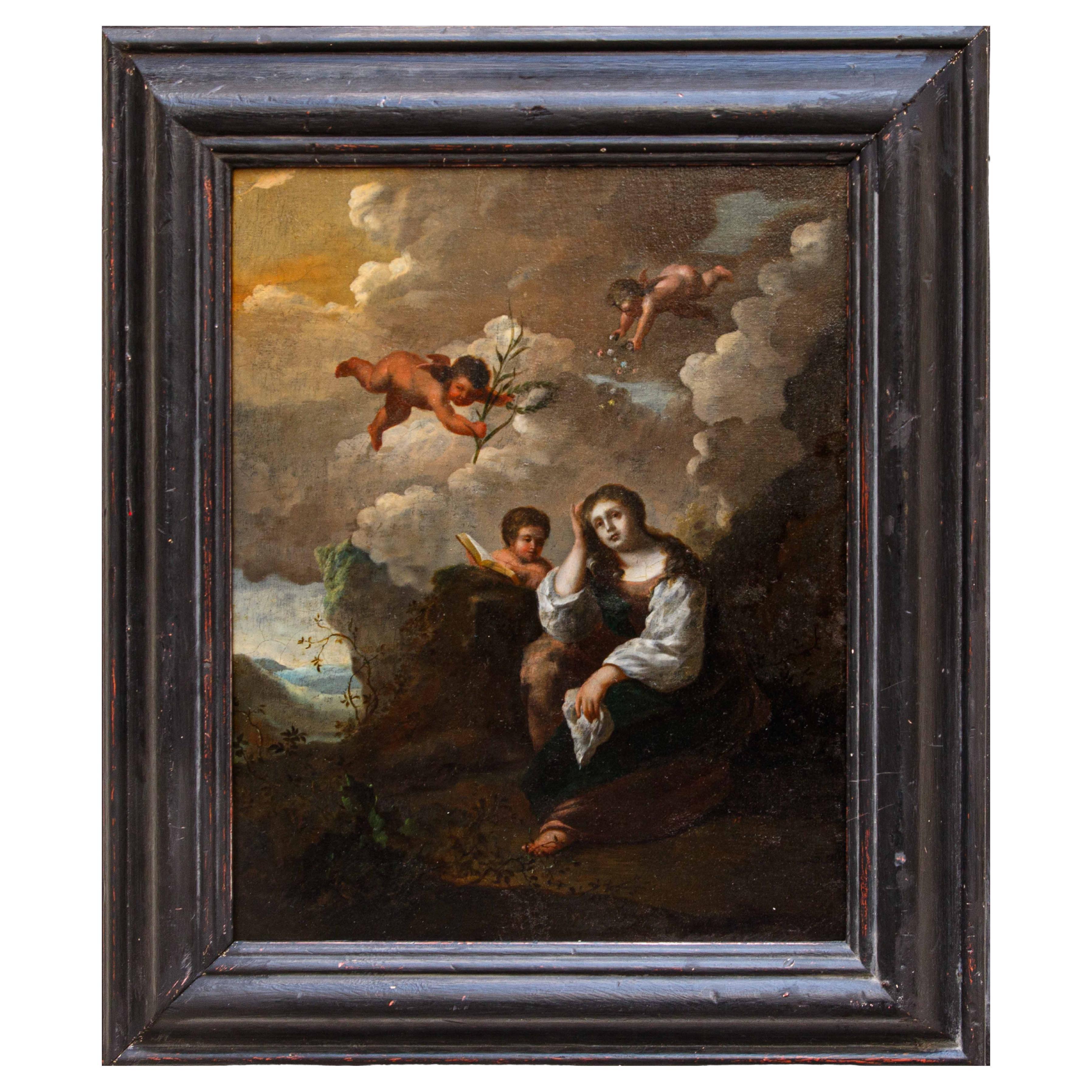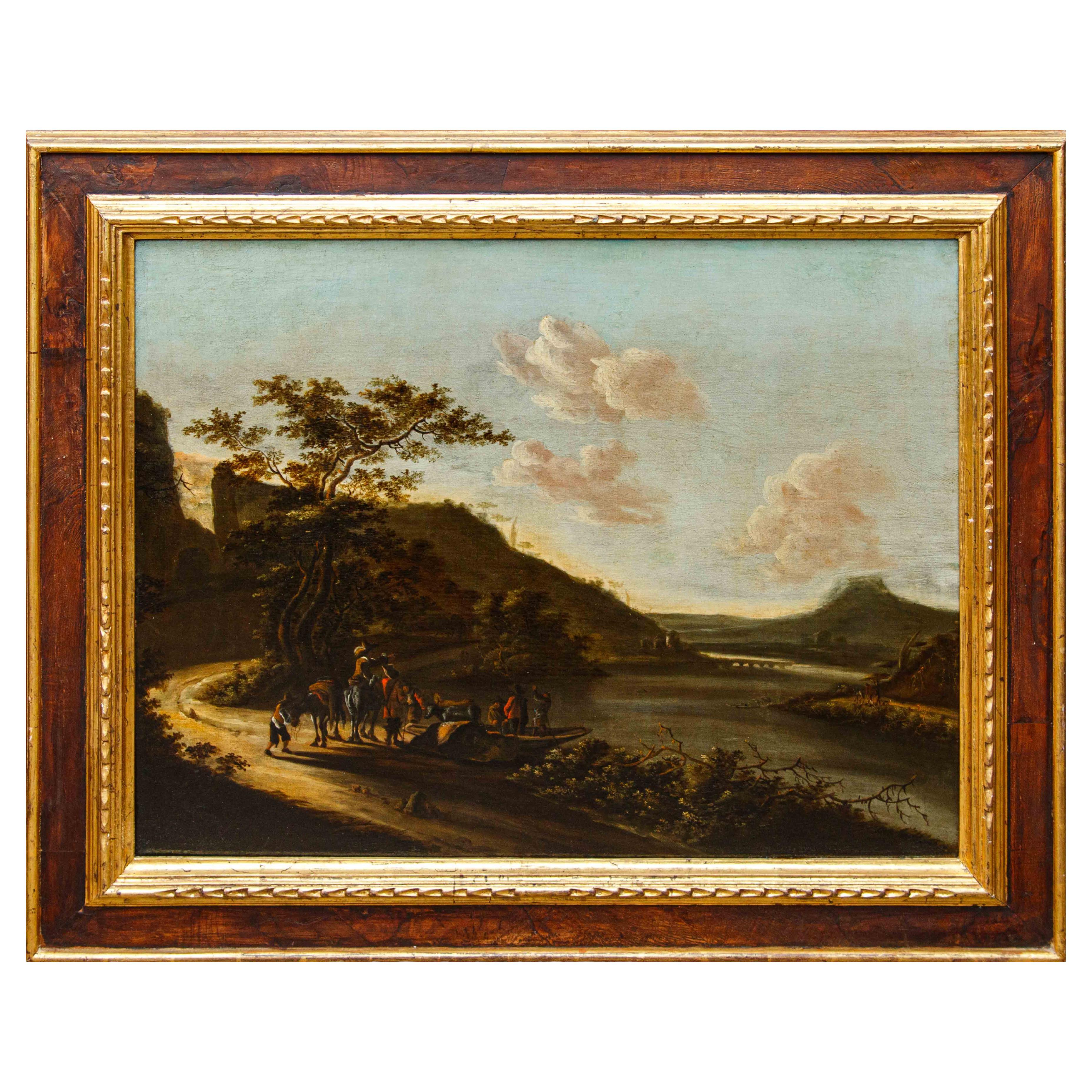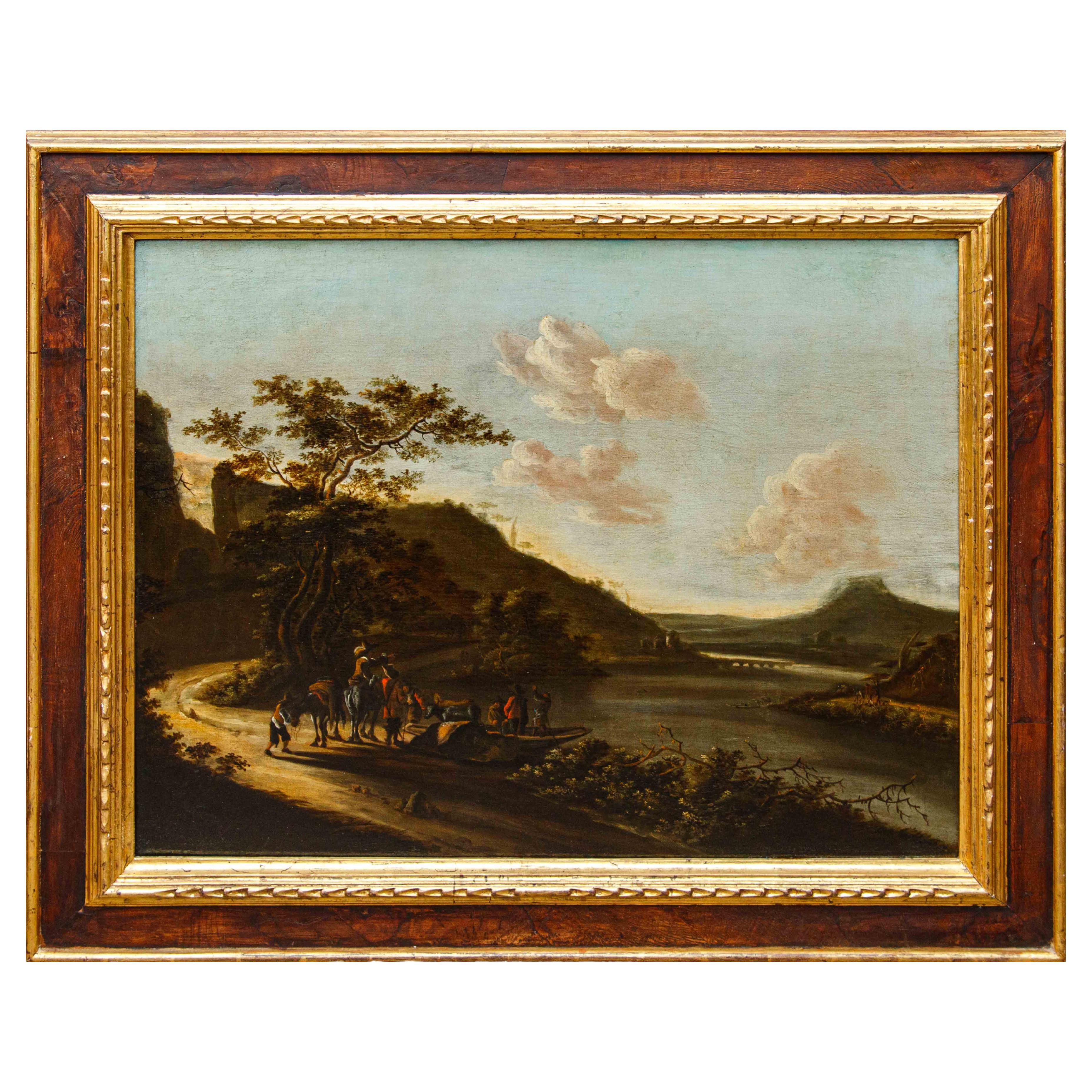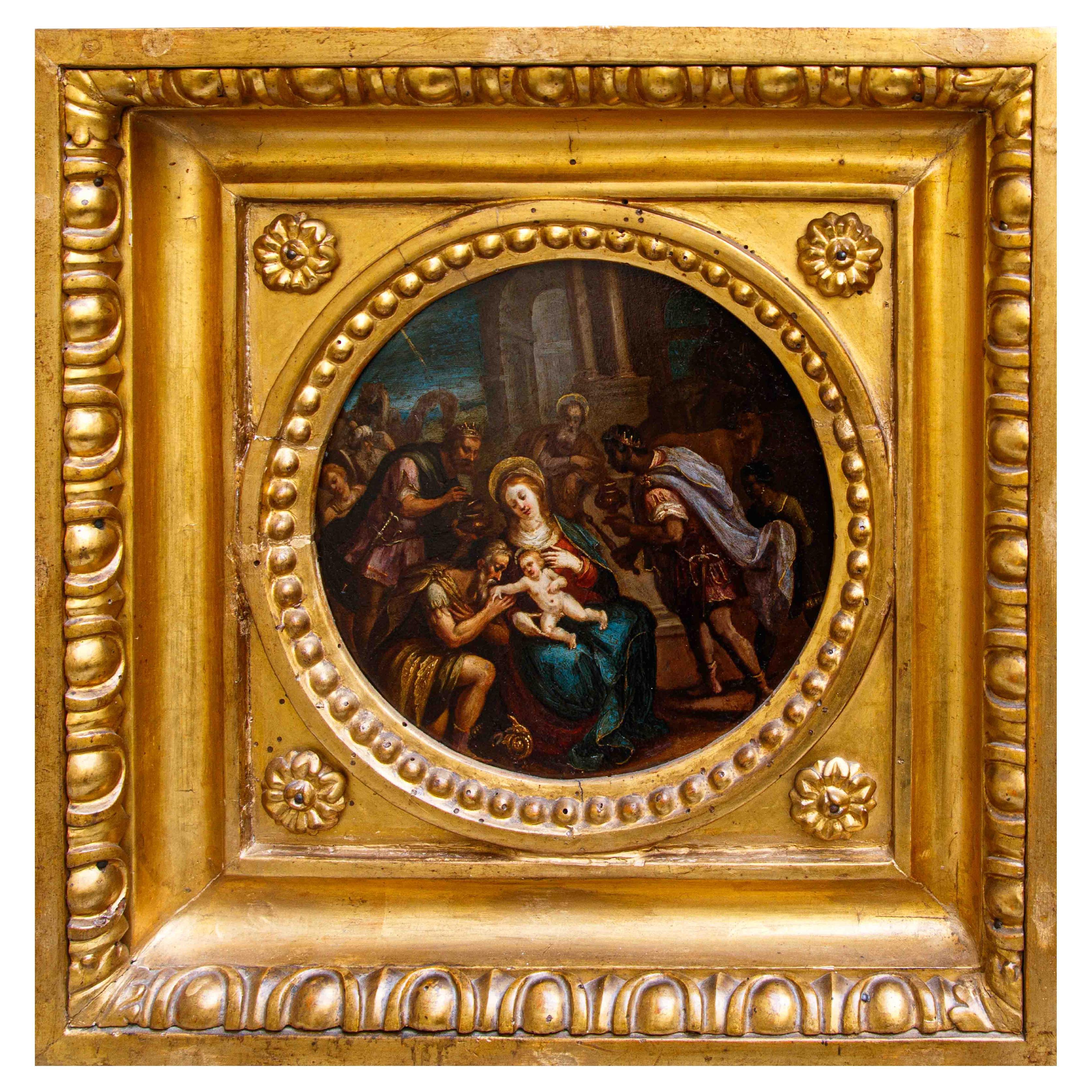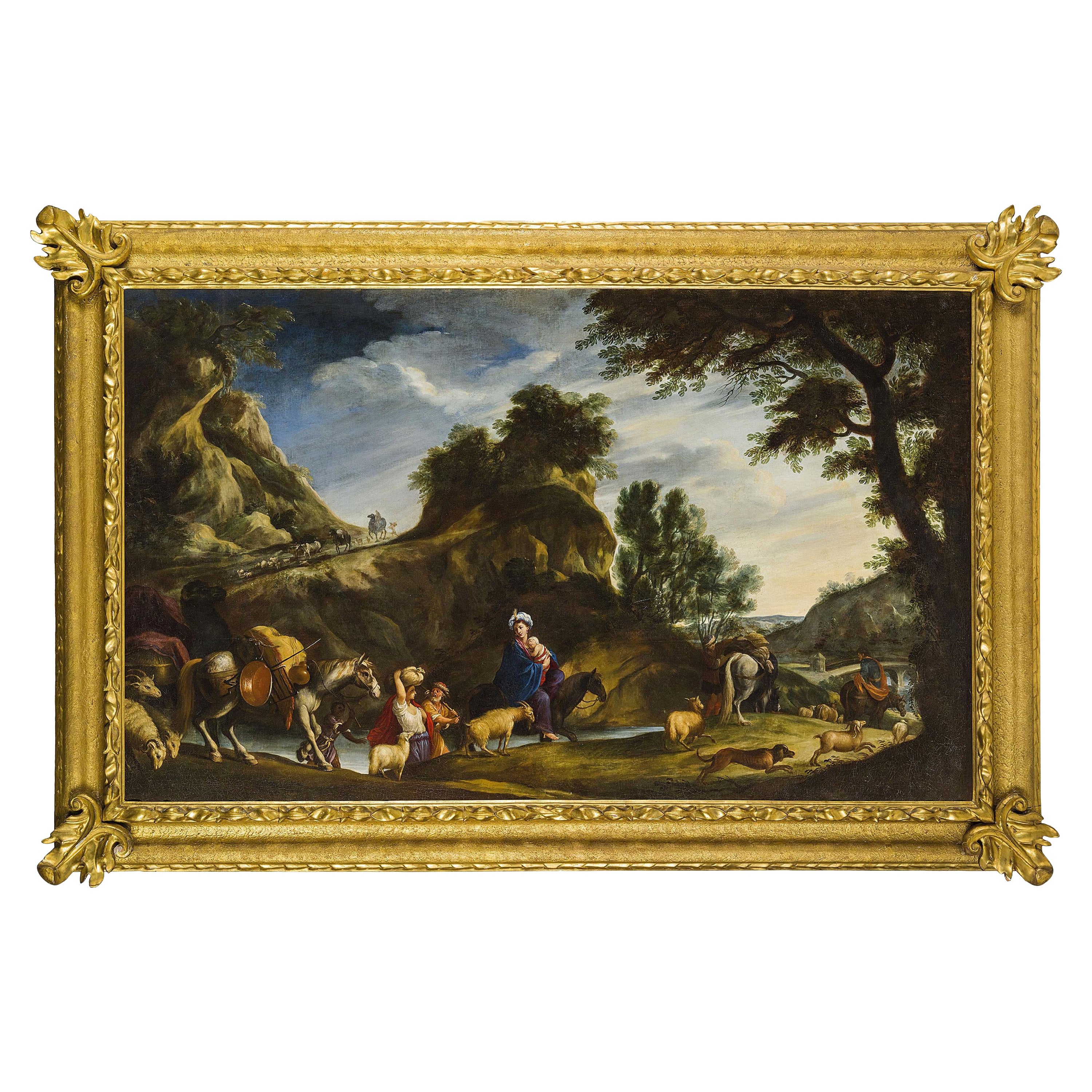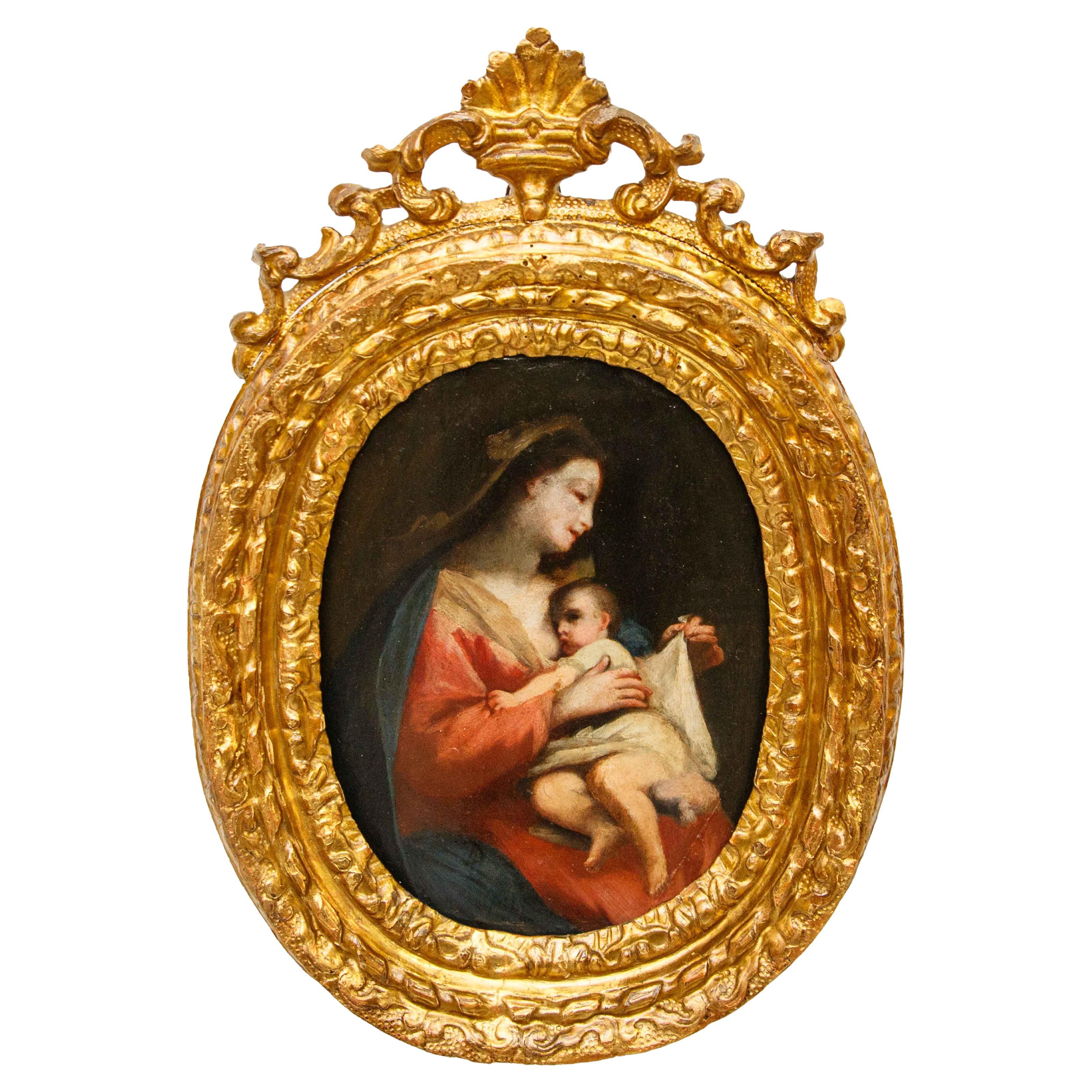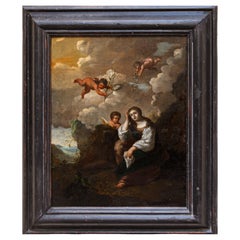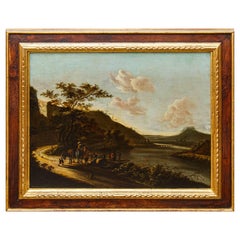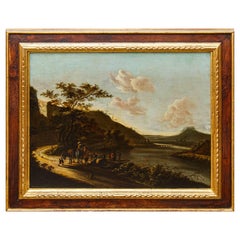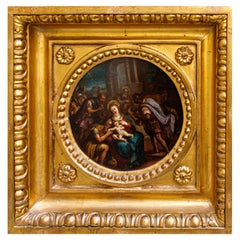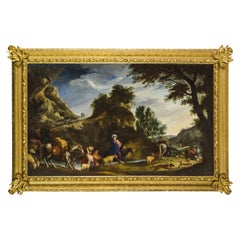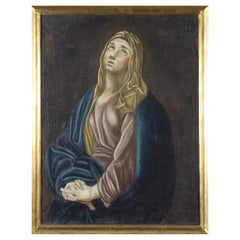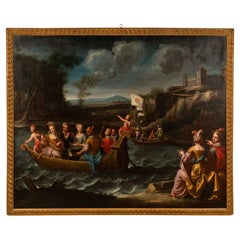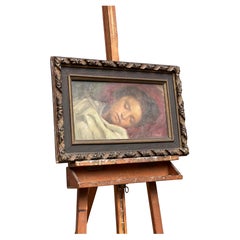Items Similar to Flemish artist active in Italy, 17th century, Penitent Magdalene
Want more images or videos?
Request additional images or videos from the seller
1 of 9
Flemish artist active in Italy, 17th century, Penitent Magdalene
$4,083.35
£3,007.38
€3,400
CA$5,555.08
A$6,172.92
CHF 3,234.68
MX$75,699.90
NOK 41,256.42
SEK 38,812.53
DKK 25,883.68
Shipping
Retrieving quote...The 1stDibs Promise:
Authenticity Guarantee,
Money-Back Guarantee,
24-Hour Cancellation
About the Item
Flemish artist active in Italy, 17th century
Penitent magdalene
Oil on panel, 37.5 x 30.5 cm
Framed, cm 53 x 45
Provenance: Luigi Bellini Gallery, Florence; Private Collection, Padua.
This painting, depicting a penitent Magdalene, features a composition with elements reminiscent of the Baroque style and Flemish influences.
In the center of the scene, Magdalene is sitting in a rocky, cloudy landscape, with an expression of deep contemplation or repentance. His posture is relaxed but his gaze is upward or outward, suggesting a spiritual dimension. She wears simple dresses with a white shirt and a darker robe that fall softly, highlighting the pleats and volumes. His right hand is resting on his cheek, a common gesture to express reflection or sadness. In his left hand he holds a white cloth.
Next to her, a putto (or child angel) is intent on reading an open book resting on a rocky surface. Its presence could symbolize divine wisdom or Scripture reading accompanying the path of penance.
Above them, in the cloudy sky, two more putti fly. One of them, in the foreground, holds a branch with leaves, perhaps a symbol of life or redemption. The clouds, painted with a certain dynamism, create an ethereal and dramatic atmosphere.
The landscape is characterized by dark rocks and sparse vegetation on the left, which contribute to an atmosphere of solitude and introspection, typical of depictions of the penitent Magdalene retreating to the desert. The light comes from above, illuminating the faces of the characters and the main parts of the scene, creating chiaroscuro contrasts that add depth to the painting. The painting style shows an attention to detail and a certain softness in the brushstrokes, typical of Flemish painting, while being set in a context and with themes dear to Italian art. Also appearing Flemish is the attitude of representing the small flowers dropped by the flying putto.
The style, although attributable to a Flemish painter active in Italy, shows a fusion of Nordic realism and the emotional drama of the Italian Baroque, with possible inspiration from Emilian compositions, such as that of Bartolomeo Schedoni preserved at the Minneapolis Institute of Arts in Minneapolis and published in the Zeri photo library, for Magdalene's pose and intense expression.
- Dimensions:Height: 11.82 in (30 cm)Width: 14.57 in (37 cm)Depth: 1.97 in (5 cm)
- Style:Other (In the Style Of)
- Materials and Techniques:Canvas,Oiled
- Place of Origin:
- Period:
- Date of Manufacture:XVII Century
- Condition:Wear consistent with age and use.
- Seller Location:Milan, IT
- Reference Number:1stDibs: LU5918245953542
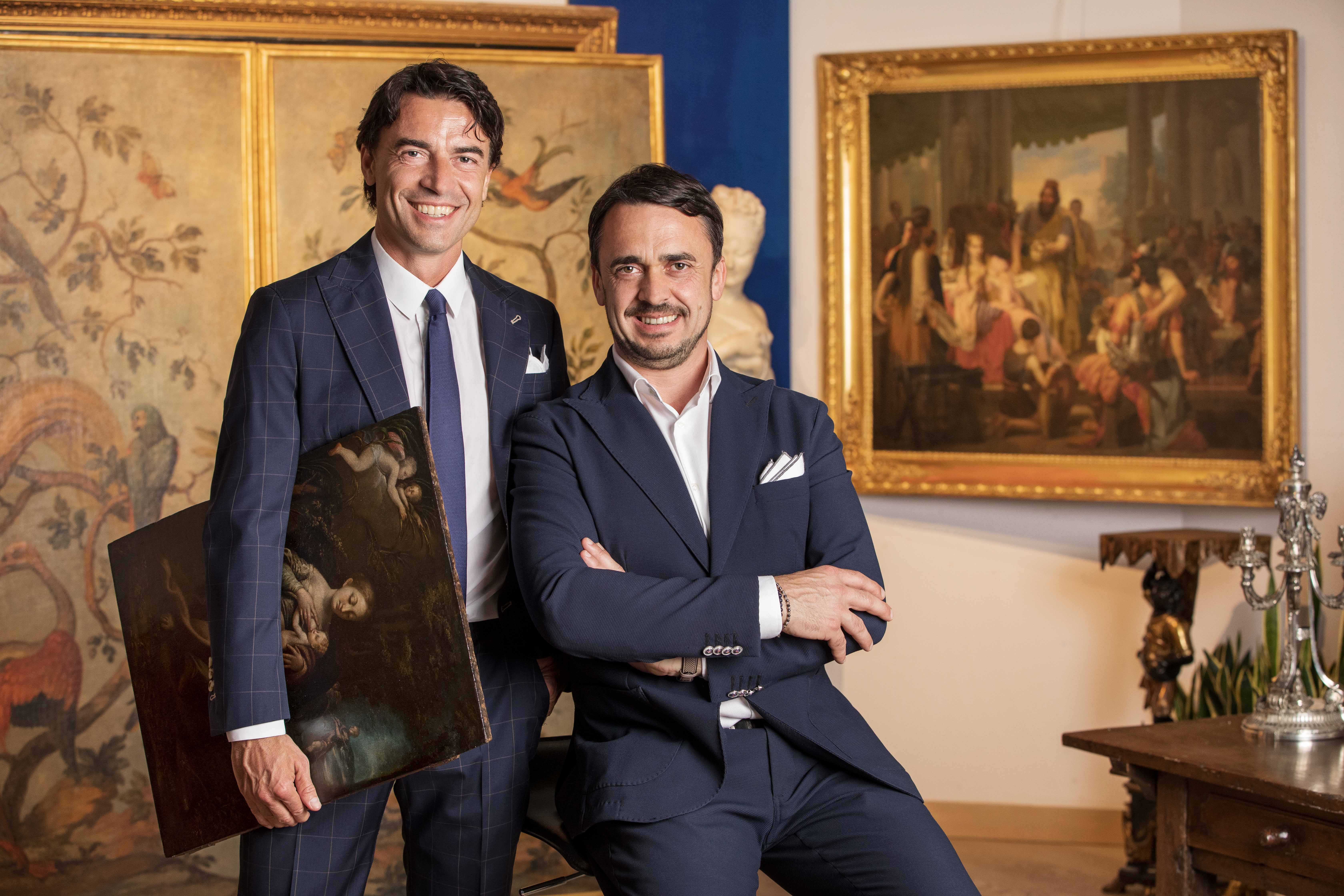
About the Seller
5.0
Vetted Professional Seller
Every seller passes strict standards for authenticity and reliability
Established in 2000
1stDibs seller since 2021
30 sales on 1stDibs
- ShippingRetrieving quote...Shipping from: Milan, Italy
- Return Policy
Authenticity Guarantee
In the unlikely event there’s an issue with an item’s authenticity, contact us within 1 year for a full refund. DetailsMoney-Back Guarantee
If your item is not as described, is damaged in transit, or does not arrive, contact us within 7 days for a full refund. Details24-Hour Cancellation
You have a 24-hour grace period in which to reconsider your purchase, with no questions asked.Vetted Professional Sellers
Our world-class sellers must adhere to strict standards for service and quality, maintaining the integrity of our listings.Price-Match Guarantee
If you find that a seller listed the same item for a lower price elsewhere, we’ll match it.Trusted Global Delivery
Our best-in-class carrier network provides specialized shipping options worldwide, including custom delivery.More From This Seller
View AllFlemish artist active in Italy, 17th century, Penitent Magdalene
Located in Milan, IT
Flemish artist active in Italy, 17th century
Penitent magdalene
Oil on panel, 37.5 x 30.5 cm
Framed, cm 53 x 45
Provenance: Luigi Bellini Gallery, Florence; Private Collection, ...
Category
Antique 18th Century and Earlier Dutch Other Paintings
Materials
Canvas
17th century, Landscape with characters
Located in Milan, IT
XVII Century
Landscape with characters
Oil on canvas, 72 x 92 cm
Framed, 95 x 112 cm
Category
Antique 18th Century and Earlier Dutch Other Paintings
Materials
Canvas
17th century, Landscape with characters
Located in Milan, IT
XVII Century
Landscape with characters
Oil on canvas, 72 x 92 cm
Framed, 95 x 112 cm
Category
Antique Late 17th Century Dutch Other Paintings
Materials
Canvas
17th century, Flemish School, Adoration of the Magi
Located in Milan, IT
17th century, Flemish School
Adoration of the Magi
Oil on copper, diam. 19.5 cm
Framed 35.3 x 35.3 cm
Engraved on the back in seventeenth-century calligraphy "Fiamingo"
Vivid wo...
Category
Antique 18th Century and Earlier Dutch Other Paintings
Materials
Copper
Mantuan school, 18th century, Madonna suckling the Child
Located in Milan, IT
Mantuan school, 18th century
Madonna suckling the Child
Oil on panel, 27.5x22 cm
The softly collected and intimate dimension suggested by the present painting underscores the cert...
Category
Antique 18th Century and Earlier Italian Other Paintings
Materials
Wood
Venetian school, Tobias and Sara in Nineveh, oil on canvas, 16th century
Located in Milan, IT
Venetian School, second half of the 16th century
Tobiah and Sarah led to Nineveh by the archangel Azariah
Oil on canvas, 48 x 56 cm - Framed, 58 x 72 cm
The present canvas, made w...
Category
Antique 16th Century Paintings
Materials
Canvas
You May Also Like
17th Century, Italian Painting by Pier Francesco Cittadini, Jacob and his Family
Located in IT
Pier Francesco Cittadini (Milan, 1616-Bologna, 1681)
"Jacob and his family go to Egypt"
Oil on canvas, cm 109 x 190 (canvas only)
The valuable painting, made in oil on canvas, depicts Jacob and his family go to Egypt and we believe it can be, given the high quality painting, autograph work of Italian Pier Francesco Cittadini (Italy Milan, 1616 - Bologna, 1681) made after 1647. The work, in excellent condition is accompanied by a coeval frame in wood finely carved and golden.
The scene depicted, which was confused with the Flight to Egypt in the past years, is instead identified with the biblical episode of Jacob’s journey. In the foreground, reading the painting from left to right, we see a caravan composed of animals, including donkeys, dromedaries, goats, dogs and horses and people, women, men and slaves, who carry on their journey along the banks of a river, following a path that to the right, would seem to lead to the through of a bridge. In addition to the watercourse is described an environment characterized by large rocks and impervious come far to cover the entire verticality of the canvas. On the left, in the distance, we see the tail of the caravan that runs along the steep path. Large trees enliven and harmonize the environment, as well as white and grey clouds characterize the predominantly clear sky and illuminated on the right by sunlight.
The story is told in the Bible, Book of Genesis, 30, 25, passage in which is described the flight of Jacob from Haran after the contrasts with Laban, father of his wife Rachel. Jacob is the third great patriarch of the Bible. From his descendants originate the twelve generations of the people of Israel. He is the son of Isaac and Rebekah, who led him to flee from the wrath of Esau to Haran to seek refuge from his brother, Laban. At his uncle’s house Jacob met his daughter Rachel. As soon as he saw his cousin, Jacob was taken. Jacob will stay seven years in the service of Laban to marry his beloved Rachel. But Laban, with a deception, will give him in marriage first Lia, the least beautiful eldest daughter, and only after another seven years the splendid Rachel. From his first wife he will have several children, while Rachel will give birth to the beloved son, Joseph, who will become viceroy of Egypt.
After years of service, Jacob asked to be paid with every dark-coloured garment among the sheep and every spotted and dotted garment among the goats. Laban accepted and sent away from his sons all the leaders of that kind. So Jacob took fresh branches of poplar, almond and plane tree, and flayed them, and put them in the troughs. The optical suggestion induced the goats and the sheep to conceive and give birth to dark, striped and dotted garments. He also ensured that all the strongest and healthiest leaders of the flock of Laban would drink near the barked branches, thus assuring a genetic superiority to his part of the flock. His flocks grew numerous and strong and he became richer than his relative, arousing envy. It was clear that Laban would not respect him much longer. At the suggestion of the Lord, Jacob decided to return to Canaan. Trying to avoid any possible dispute, he left with his family while Laban was absent for shearing sheep. But when, three days later, his uncle returned home, he became angry, feeling offended because Jacob had gone secretly and had not allowed him to greet his daughters and grandchildren. In addition, his teraphim, statuettes, or idols, which depicted the family deities, had disappeared. After 7 days of pursuit, Laban and his men reached Jacob’s group on Mount Gilead, in the mountainous region west of the Euphrates River, where his uncle and grandson had a stormy conversation. The younger man was outraged at being accused of stealing idols and told Labano to rummage through his family’s tents at will. Neither of them could know or even imagine that it was Rachel who took the idols and hid them in the saddle of the camel. During the search, she sat down firmly on the saddle, apologizing for not being able to get up, «because I usually have what happens to women» (Gen 31:35). So the loot wasn’t discovered.
The author of this work was inspired by the composition of an engraving by Stefano Della Bella (1610-1664) of circa 1647. The engraving by Stefano della Bella bears the title "Iacob sur ses vieux jours quitte sans fascherie pour voir son filz Ioseph, sa terre et sa patrie" and is signed on the bottom left "Stef. of the Beautiful In. et fe." while on the right it is declared "Cum privil. Regis", that is with license of the king.
Stefano Della Bella (Italy - Florence, May 18, 1610-Florence, July 12, 1664) was born in a family of painters, sculptors and goldsmiths and was left early orphan of his father sculptor, he dedicated himself first to the art of goldsmith at the school of Giovanni Benedetto Castiglione and Gasparo Mola, then turning his attention to drawing and engraving. He soon began drawing figures and copying the etchings of Jacques Callot, which inspired his early works. Under the protection of the Medici, in particular of Don Lorenzo, cadet son of Grand Duke Ferdinand I, Della Bella has the opportunity to make study trips to Rome, where he stayed from 1633-1636; In Rome he met French engravers and publishers of prints such as Israël Henriet and François Langlois, who influenced his decision to move to Paris in 1639, four years after the death of Callot. In Paris he soon reached, thanks to the engravings commissioned by Cardinal Richelieu, the success also worldly; he frequented courtiers, theatre artists and writers, while refusing too oppressive honors. In 1646-1647 he continued his travels in the Netherlands to Amsterdam, Antwerp and Dordrecht. He returned to Florence in 1650 and resumed working under the protection of the Medici court, working for his patrons. In 1656 he became a member of the Academy of Apatists.
The painting object of this study is reasonably attributable to Pier Francesco Cittadini, or Pierfrancesco Cittadini, called the Milanese or the Franceschino (Italy - Milan, 1616-Bologna, 1681) as some exemplary stylistic comparisons proposed to follow can prove.
Pier Francesco Cittadini was an Italian baroque painter, mainly active in Bologna.
His artistic training first took place with the painter Daniele Crespi...
Category
Antique Mid-17th Century European Baroque Paintings
Materials
Canvas, Giltwood
Antique painting Our Lady of Sorrows 18th century
Located in Cesena, FC
Antique painting Our Lady of Sorrows, 18th century
Oil on canvas 101 x 75 cm
Anonymous painter.
The painting in general is assumed to be Lombard from the first half of the 1700s, ye...
Category
Antique 1730s European Paintings
Materials
Canvas
Italian 18th Century Oil on Canvas from the Piedmont Region
Located in West Palm Beach, FL
A sensational and large scale Italian 18th century oil on canvas from the Piedmont region. The beautiful painting is set in its original polychrome frame which displays a lovely carv...
Category
Antique 18th Century Italian Paintings
Materials
Canvas, Wood
Dipinto Cirinna, Raffigurazione Di Fanciulla, Vintage, Firmato, Inizi xx S
Located in Milano, MI
dipinto cirinna - raffigurazione di fanciulla - vintage - firmato - inizi xx s
Descrizione :
raffigurazione di fanciulla dormiente
Origini :
Italia
Periodo di produzion...
Category
20th Century Italian Paintings
Materials
Canvas
Italian 13th century oil on canvas painting "Lot and Daughters"
Located in Cesena, FC
Lot and his daughters, EMILIAN SCHOOL
XVIIIth century
Oil on canvas 175 x 126 cm
Lot and his daughters is one of the themes most frequently encountered by seventeenth-century pain...
Category
Antique 18th Century Italian Baroque Paintings
Materials
Canvas, Paint
Mid-20th Century Italian Painting
Located in Chicago, IL
This beautiful painting is from Italy and made circa 1950s-1960s. Made from paint on canvas the painting features a gold wooden frame; artist unknown. Great piece to add color to you...
Category
Mid-20th Century Italian Paintings
Materials
Canvas, Wood, Paint
